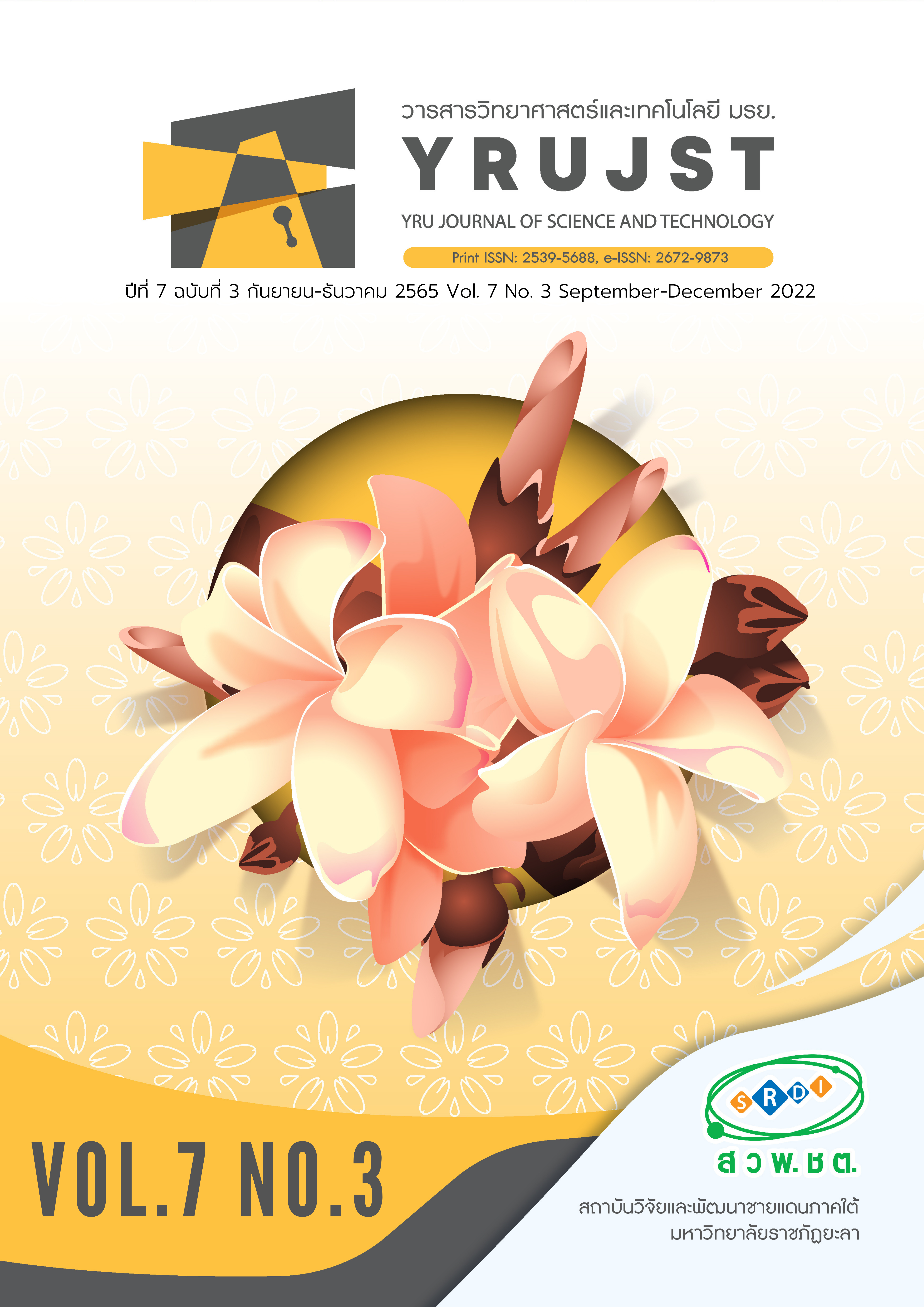Bacillus cereus contamination in Thai sweet cereal bar of community products in Kamphaeng Phet Province
Main Article Content
Abstract
Krayasart is a community product that the general public buys as a souvenir of Kamphaeng Phet Province. The purpose of this research aims to analyze Bacillus cereus (B. cereus) in Krayasart products by the Standard Plate Count method using the standard of the Bacteriological Analytical Manual (BAM) from 7 September to 10 November 2019. To determine the bacterial contamination, seven brands of Krayasart products were randomly examined six times in a total of 42 samples. The results showed that the average amount of bacteria contamination in the samples examined was 5 – 10 CFU/g (9.52%). All isolates were tested for biochemical properties. 4-1-3(2) isolates were randomly collected and investigated the 16s rRNA nucleotide sequence analysis to confirm the name in which it was found to be a subtype of B. cereus. From all results, Krayasart could be considered at low risk of diarrhea or vomiting caused by toxins generated from B. cereus to consumers and passed standards for pathogenic microorganisms in food. Notification of the Ministry of Public Health (No. 416) B.E. 2563 stipulates that ready-to-eat foods with free water content (aW) < 0.85 containing cereals or beans in which the level of B. cereus contamination shall not be more than 1,000 CFU/g.
Article Details

This work is licensed under a Creative Commons Attribution-NonCommercial-NoDerivatives 4.0 International License.
บทความ ข้อมูล เนื้อหา รูปภาพ ฯลฯ ที่ได้รับการเผยแพร่ในวารสารวิทยาศาสตร์และเทคโนโลยี มรย. นี้ ถือเป็นลิขสิทธิ์ของวารสารวิทยาศาสตร์และเทคโนโลยี มรย. หากบุคคลหรือหน่วยงานใดต้องการนำทั้งหมดหรือส่วนหนึ่งส่วนใดไปเผยแพร่ต่อหรือกระทำการใดๆ จะต้องได้รับอนุญาตเป็นลายลักษณ์อักษรจากวารสารวิทยาศาสตร์และเทคโนโลยี มรย. ก่อนเท่านั้น
References
Berthold-Pluta, A., Pluta, A., Garbowska, M. & Stefańska, I. (2019). Prevalence and toxicity characterization of Bacillus cereus in food products from Poland. Foods, 8(7), 1-12.
Cynthia, B. J. & Larry, R. B., (1998). Survival and growth of Psychrotrophic Bacillus cereus in dry and reconstituted infant rice cereal. Journal of Food Protection, 61(12), 1629-1635.
Dietrich, R., Jessberger, N., Ehling-Schulz, M., Märtlbauer, E., & Granum, P.E. (2021). The food poisoning toxins of Bacillus cereus. Toxins, 13, 98.
Frankland, G. C. & Frankland, P. F. (1887). Studies in some new micro-organisms obtained from air. Philos. Trans. R. Soc. Lond., 178, 257–287.
Rahnama, H., Azari R., Yousefi, M.H., Berizi, E., Mazloomi, S. M., Hosseinzadeh, S., Derakhahan, Z., Ferrante, M., & Conti, G. O. (2022). A systematic review and meta-analysis of the prevalence of Bacillus cereus in foods. Food control, 143, 109250
Rodrigo, D., Rosell, C. M., & Martinez, A. (2021). Risk of Bacillus cereus in Relation to Rice and Derivatives. Foods, 10(2), 1-11.
Xu, J., Janahar, J. J., Park, H. W., Balasubramaniam, V. M., & Yousef, A. E. (2021). Influence of water activity and acidity on Bacillus cereus spore inactivation during combined high pressure-thermal treatment. LWT - food science and technology, 146, 111465.
Jovanovic, J., Tretiak, S., Begyn, K., & Rajkovic, A. (2022). Detection of enterotoxigenic psychrotrophic presumptive Bacillus cereus and cereulide producers in food products and ingredients. Toxins, 14, 289.
Kukkong, P., Plansae, S., Thimthai, T., Thammakhanthaun, P. & Phumnoi, N. (2018). The Methods to improve marketing of Mea Sanong’s Thai sweet cereal bar product in Lan Dok Mai Sub-District, Kosamphi Nakhon District, Kamphaeng Phet. The 5th National conference KPRU, December 21, 2018. Kamphaeng Phet Rajabhat University. (in Thai).
Sapapporn, N. & Noiphan, P. (2016). Prevalence of Bacillus cereus in chili paste, Amphur muang, Kamphaeng Phet. The 12nd Naresuan research conference, July 21-22, 2016. Phitsanulok: Naresuan University. (in Thai).
Rachel, M. A., Sarah, B. M., David K. J., Laura C. M., Nicole M. H., Kathryn, B. J. & Jasna, K. (2016). Bacillus wiedmannii sp. nov., a psychrotolerant and cytotoxic Bacillus cereus group species isolated from dairy foods and dairy environments. International Journal of Systematic and Evolutionary Microbiology, 66(11), 4744–4753.
Simmonds, P., Mossel, B. L., Intaraphan, T. & Deeth, H. C., (2003). Heat resistance of Bacillus spores when adhered to stainless steel and its relationship to spore hydrophobicity. Journal of Food Protection, 66 (11), 2070–2075.
Tallent, S. M., Knolhoff, A., Rhodehamel, E. J., Harmon, S. M., & Bennett R. W. (2020). Chapter 14: Bacillus cereus. In: Bacteriological analytical manual (BAM). [Online]. Retrieved Nov 12, 2022, from: URL: https://www.fda.gov/food/laboratory - methods - food/bam - bacil- lus - cereus.


